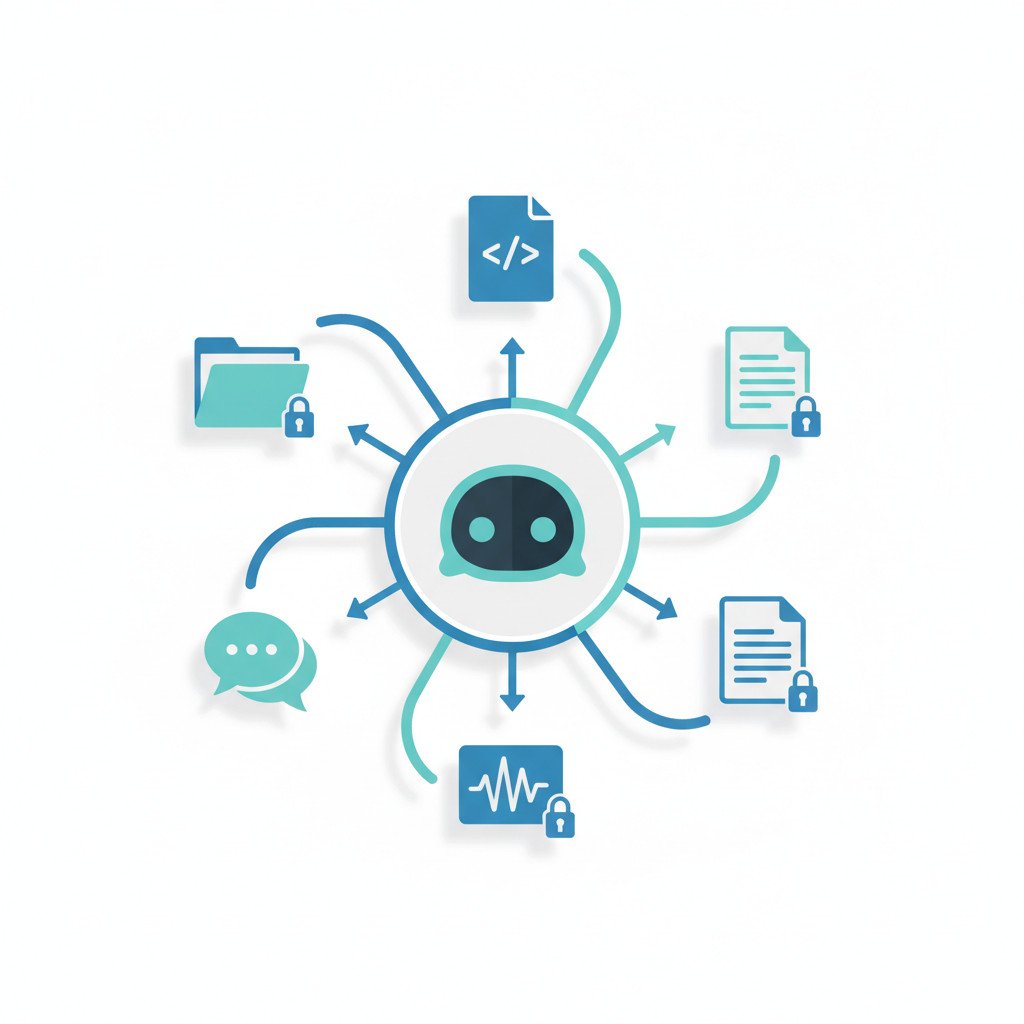How ChatGPT Connected to Enterprise Data Is Transforming Knowledge Work
Finding the right document or answer inside large organizations often feels like searching for a needle in a haystack. Enterprise data knowledge surfacing with ChatGPT promises to change that for knowledge workers and IT teams. By connecting ChatGPT to Slack, SharePoint, Google Drive, GitHub, and other apps, context surfaces where work happens. However, speed and convenience are only part of the picture because security and governance matter too.
Leaders must balance productivity gains with data privacy, permissions, and compliance needs. Moreover, admins need strong controls such as encryption, SSO, SCIM, IP whitelisting, and audit logs. Therefore, teams should pilot realistic tasks to measure ROI and validate governance. Because ChatGPT only sees data a user already can access, permission design becomes critical.
This article explores how enterprise connectors, data residency, and access control shape outcomes for CIOs. We will highlight trade offs, governance patterns, and practical pilot steps for teams. As a result, readers will learn how to unlock knowledge while keeping data safe and compliant.
Enterprise data knowledge surfacing with ChatGPT
Enterprise data knowledge surfacing with ChatGPT transforms scattered files and messages into actionable answers. In practice, ChatGPT connects to enterprise apps so people can find context fast. As a result, teams stop wasting hours searching folders and chat histories. Moreover, the system returns answers with citations so users can verify sources quickly.
How it unlocks knowledge
- Connectors integrate tools like Google Drive and Slack so ChatGPT can read relevant documents and conversations. See testing details at this article for the initial rollout.
- A GitHub connector helps engineers ask questions about codebases and pull requests. For more, read this article.
- OpenAI added broader cloud storage and meeting recording connectors to expand coverage. Learn about those updates at this article.
Key benefits
- Faster decision making because answers come from internal context.
- Reduced information silos since disparate sources become searchable.
- Verifiable outputs because responses include source links.
Governance and practical notes
- Permission controls matter because ChatGPT only sees what users already can access. Therefore, design role based access carefully.
- Admins should pilot complex queries to validate accuracy and measure ROI. Ultimately, well governed surfacing increases productivity while protecting enterprise data.

Evidence and use cases: Why enterprise data knowledge surfacing with ChatGPT delivers value
Enterprises gain measurable benefits when they enable enterprise data knowledge surfacing with ChatGPT. For example, teams report faster time to answer because the model pulls context from Slack, Drive, and GitHub. Moreover, early rollouts and beta testing show connectors speed retrieval and reduce search time. See testing notes and connector details at TechCrunch article on testing notes.
Representative use cases
- Customer support: Agents get instant, cited answers from product docs and prior tickets. As a result, response times fall and satisfaction rises.
- Engineering and devops: Developers query code, PRs, and issue trackers to resolve bugs faster. For a real example, read about the GitHub connector here TechCrunch article on GitHub connector.
- Sales and bids: Reps surface internal case studies and pricing notes to tailor proposals quickly.
- Legal and compliance: Counsel finds policy drafts and audit trails, which supports faster reviews.
- Meetings and knowledge capture: Recordings and transcriptions feed searchable context. See updates on meeting recording connectors at TechCrunch article on meeting recording connectors.
Observed benefits
- Reduced time wasted searching multiple systems
- Higher quality answers with source citations
- Fewer duplicated documents and knowledge gaps
- Improved cross team collaboration and onboarding
Comparison table: ChatGPT powered surfacing versus traditional methods
| Feature | ChatGPT powered surfacing | Traditional methods |
|---|---|---|
| Discovery speed | Real time synthesis from connected apps. Benefit: minutes saved per query. | Manual search across drives and chats. Benefit: inconsistent results and delays. |
| Contextual accuracy | Provides source citations and document snippets. Benefit: verifiable answers. | Often missing context and provenance. Benefit: lower trust in results. |
| Cross system search | Unified view across Slack, Drive, GitHub, and more. Benefit: removes silos. | System by system search. Benefit: fragmented knowledge. |
| Governance controls | Admin roles, permission-respecting access, audit logs. Benefit: compliant use. | Ad hoc sharing and manual audits. Benefit: higher risk and overhead. |
Taken together, evidence suggests that well governed surfacing improves productivity. Therefore, pilot with high value workflows and measure outcomes. Ultimately, linking ChatGPT to enterprise data converts scattered knowledge into usable insights.
How to implement enterprise data knowledge surfacing with ChatGPT
Start with a clear use case and success metric. First, pick a single high value workflow to pilot. For example, choose customer support or developer on call queries. Next, map data sources such as Slack, SharePoint, Google Drive, GitHub, and meeting recordings. Then, inventory permissions and owners so you know who controls access. Because ChatGPT respects existing permissions, this step matters.
Integration steps
- Configure connectors and scopes. Add connectors for each app and limit scopes to required folders. As a result, you reduce exposure.
- Set admin roles and SSO. Use SCIM, IP whitelisting, and Compliance API for audit trails.
- Prepare and curate data. De-duplicate, tag, and add consistent naming. Also, remove stale or sensitive files.
- Define governance policies. Create role based access and regular review cycles. Therefore, you maintain compliance and privacy.
- Train pilot users. Provide short sessions, example prompts, and quick reference guides. Encourage feedback and bug reports.
- Measure and iterate. Track time saved, answer accuracy, and user satisfaction. Then expand connectors based on measured ROI.
Security and operational tips
- Use encryption at rest and in transit.
- Log access via Compliance API and feed logs to your SIEM.
- Apply least privilege and fine grained permissions.
- Restrict external web searching during early pilots to avoid drift.
Finally, communicate expectations and timeline to stakeholders. Pilot small, measure results, and scale only when governance proves effective.
CONCLUSION
Enterprise data knowledge surfacing with ChatGPT changes how companies find and use internal knowledge. By connecting ChatGPT to apps and repositories, teams get faster, cited answers from the systems they already use. Moreover, this reduces duplicated work and speeds decision making across support, engineering, sales, and compliance.
However, the shift demands strong governance and careful permission design. Therefore, organizations must pilot with clear metrics, apply least privilege, and log activity for audits. As a result, well governed surfacing turns scattered files into reliable insights while protecting privacy and compliance.
EMP0 can help organizations realize these gains. EMP0 is a US based AI and automation solutions company focused on sales and marketing automation. Its offerings include Content Engine, Marketing Funnel, Sales Automation, and proprietary AI tools built for growth. EMP0 combines integration expertise and operational playbooks to accelerate pilots and scale safely.
To explore AI powered growth and automation, consider EMP0 as a partner for design and implementation. Visit the website and resources to learn more: EMP0 Website and EMP0 Articles. Also see EMP0 on automation integrations at EMP0 on n8n.
Finally, pilot small, measure results, and scale when governance proves effective.
Frequently Asked Questions (FAQs)
What is enterprise data knowledge surfacing with ChatGPT?
It connects ChatGPT to internal apps and repos to surface cited, relevant answers from enterprise data, reducing search time.
How does ChatGPT access company data safely?
It uses approved connectors and honors existing permissions, plus admins can enforce SSO, SCIM, IP whitelisting, and encryption.
Will my data be used to train the model?
By default OpenAI does not train on enterprise data, but confirm tenant settings and contract terms to be sure.
What governance should we put in place?
Define role based access, limited connector scopes, least privilege, regular audits, and logging via a Compliance API.
How do we measure ROI from a pilot?
Track time saved, answer accuracy, ticket resolution rates, and user satisfaction to quantify productivity gains and cost savings.
How do we start a pilot?
Pick a high value workflow, map sources, configure limited connectors, train users, and measure outcomes before scaling.

